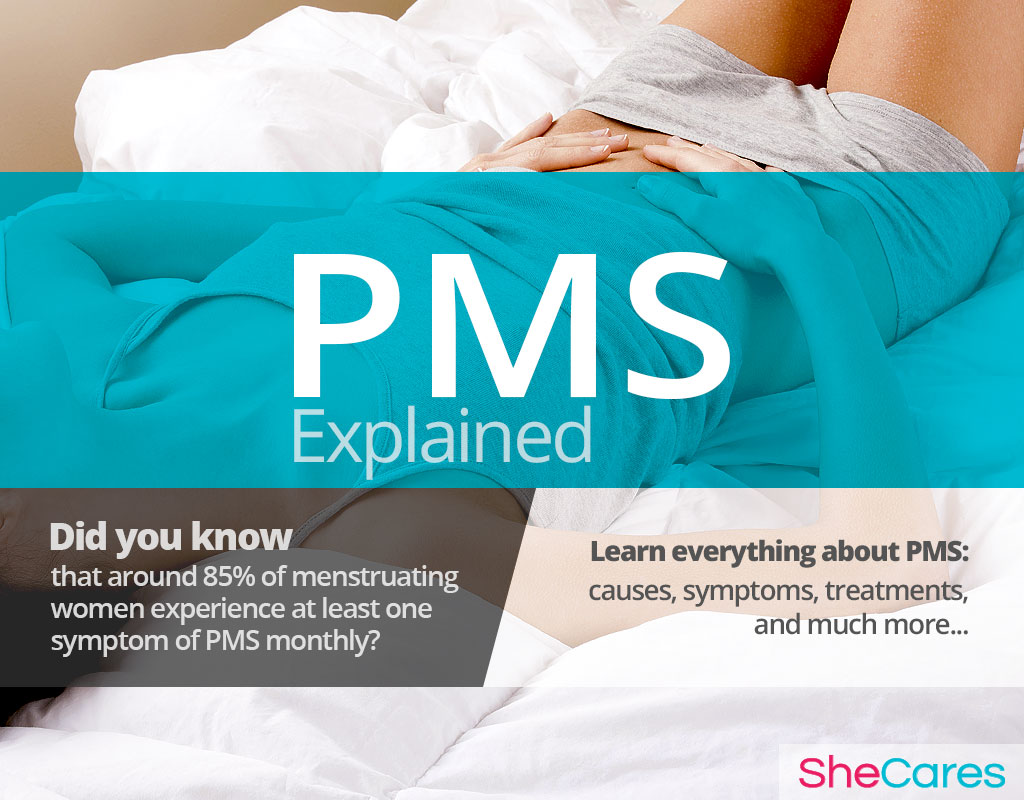About
Quick Facts about PMS
- Around 85% of menstruating women experience at least one symptom of PMS each month.
- Premenstrual dysphoric disorder is a more severe form of PMS characterized by more intense mood-related symptoms.
- PMS is more common in women who have had at least one child.
Women can begin experiencing PMS as soon as they have had their menarche, or first period. However, it's more common in women in their late twenties to early forties. Women who have a history of mood disorders are also more likely to experience symptoms of PMS. Naturally, once menstruation stops with menopause, women will no longer experience PMS.
Identifying PMS
Women may wonder if the symptoms they are experiencing are really connected to their periods or if they are unrelated. This is especially the case with non-specific symptoms like fatigue and aches and pains. Typically, PMS symptoms appear somewhere within the range of 7 - 14 days before monthly bleeding. Although symptoms vary from woman to woman, the same individual will general experience the same kind of symptoms every cycle, though some variance is also normal.
Continue to the next section for information on what causes PMS.
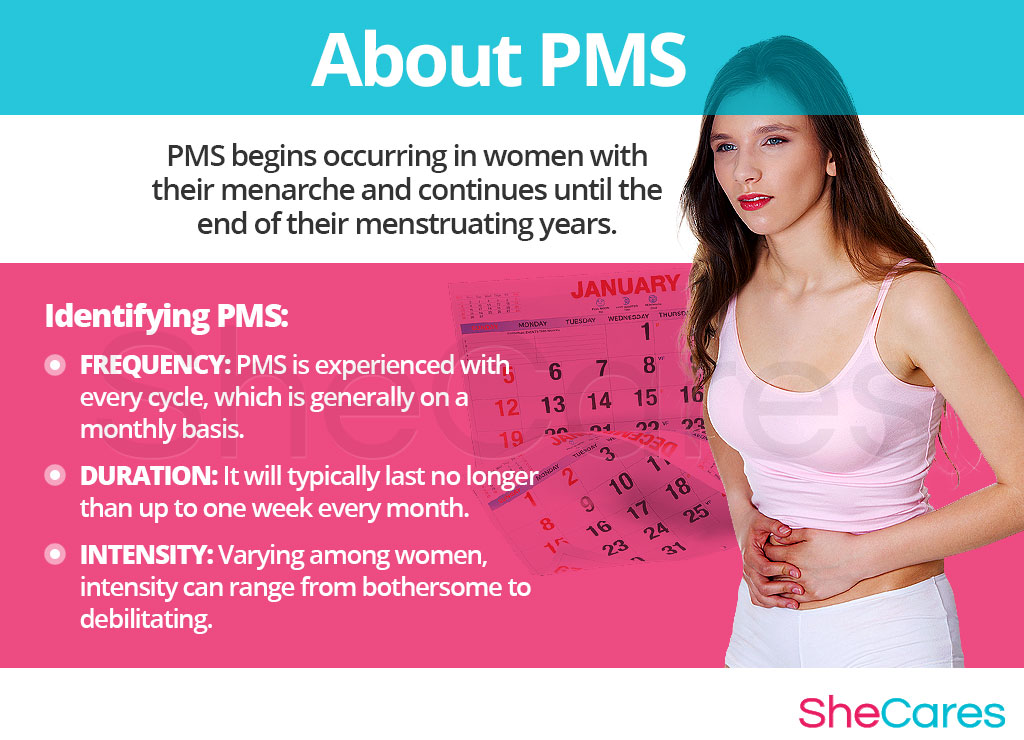
Causes
Although the exact cause of PMS has not been ascertained, several factors have been identified that influence the experience of the syndrome. It is thought that the primary cause of the various symptoms of PMS is hormonal imbalance that results from natural fluctuations in the menstrual cycle. Other factors can also contribute to PMS symptoms.
Hormonal Causes of PMS
The menstrual cycle is regulated by hormones such as estrogen and progesterone, among others. However, these hormones have other roles in the body aside from regulating menstruation and reproduction in general. In fact, estrogen and progesterone have effects on systems as diverse as the nervous, musculoskeletal, digestive, and cardiovascular systems; nearly every part of the body is influenced by these hormones in some way.
During the first half of the menstrual cycle, estrogen levels rise, which causes the uterus lining to thicken in preparation for a potential pregnancy. At about the midway point of the cycle, the levels of progesterone and other hormones increase to trigger the release of an egg and further prepare the uterus for a possible pregnancy. If the egg is not fertilized, then hormone levels drop, which causes the uterine lining to shed in what is known as a period. This natural drop in hormone levels is also associated with the symptoms of PMS.
Other, Less Common Causes of PMS
Other factors, like stress and nutrient deficiencies, can also cause or contribute to PMS.
It is not known why some women are more greatly affected by natural hormonal shifts in the menstrual cycle than others, though genes may be an influence.
Keep reading to learn about the different signs and symptoms associated with PMS.
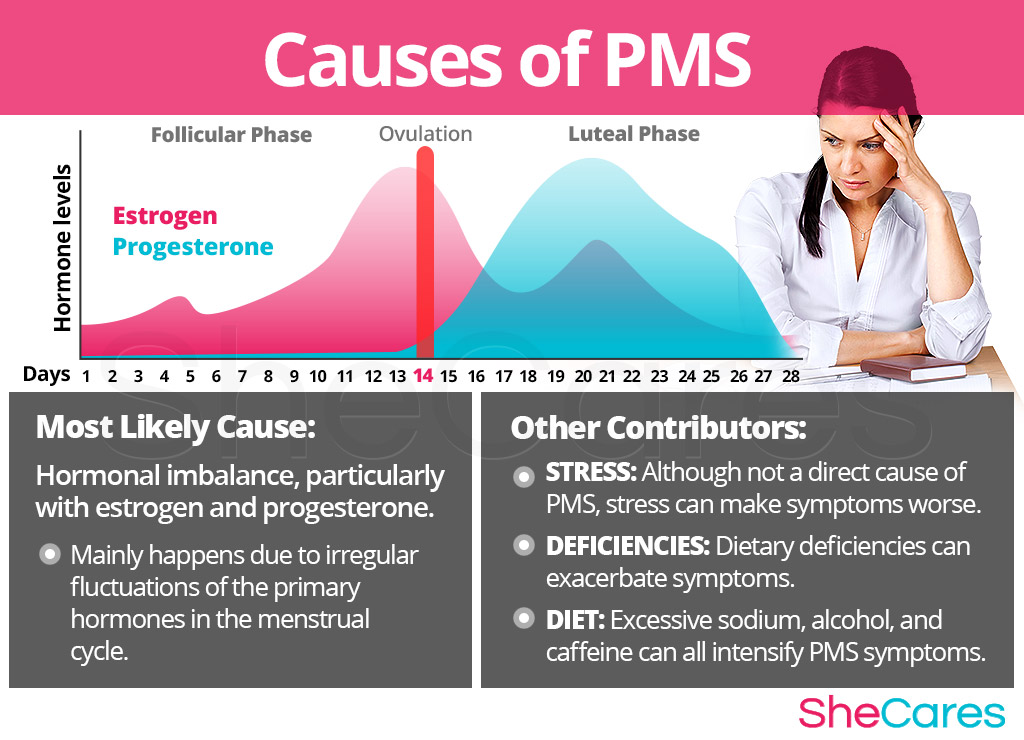
Signs and Symptoms
One of the most well-known symptoms of PMS is mood swings, but not all women with PMS have mood swings, and not all women with mood swings experience them as a part of PMS. There are many possible symptoms that factor into this syndrome, and they are all associated with changes in hormone levels during the menstrual cycle.
Symptoms of PMS
- Frequent changes in mood or behavior
- Tearfulness
- Breast pain or tenderness
- Migraines or other headaches
- Acne
- Fatigue or low energy levels
- Changes in appetite or cravings
- Joint or muscle pain
- Digestive problems, such as constipation or diarrhea
- Trouble sleeping
- Difficulty concentrating
- Anxious spells
- Swelling or bloating
Diagnosis of PMS
It is unlikely that an individual will experience all of the above symptoms at once. In fact, a woman need exhibit but one of the below symptoms to be diagnosed with PMS, as long as the symptom is experienced consistently every month before her cycle. To diagnose and identify PMS, a doctor must typically perform three or four procedures. First, he or she should review the patient's medical history, then conduct a physical exam, and finally do a psychological evaluation. The doctor may also order additional tests.
Complications of PMS
While PMS does not have particular complications per se, its symptoms can be mistaken for more severe conditions that warrant medical attention. These conditions are less common than PMS itself, and just because a woman is experiencing the associated symptoms does not mean she necessarily has the disorder. However, care should be taken, especially in women with intense mood-related symptoms.
Women who experience severe PMS symptoms that lower their quality of life often seek ways to manage and treat their symptoms. Continue reading for information on lifestyle, alternative, and pharmaceutical treatments for PMS.
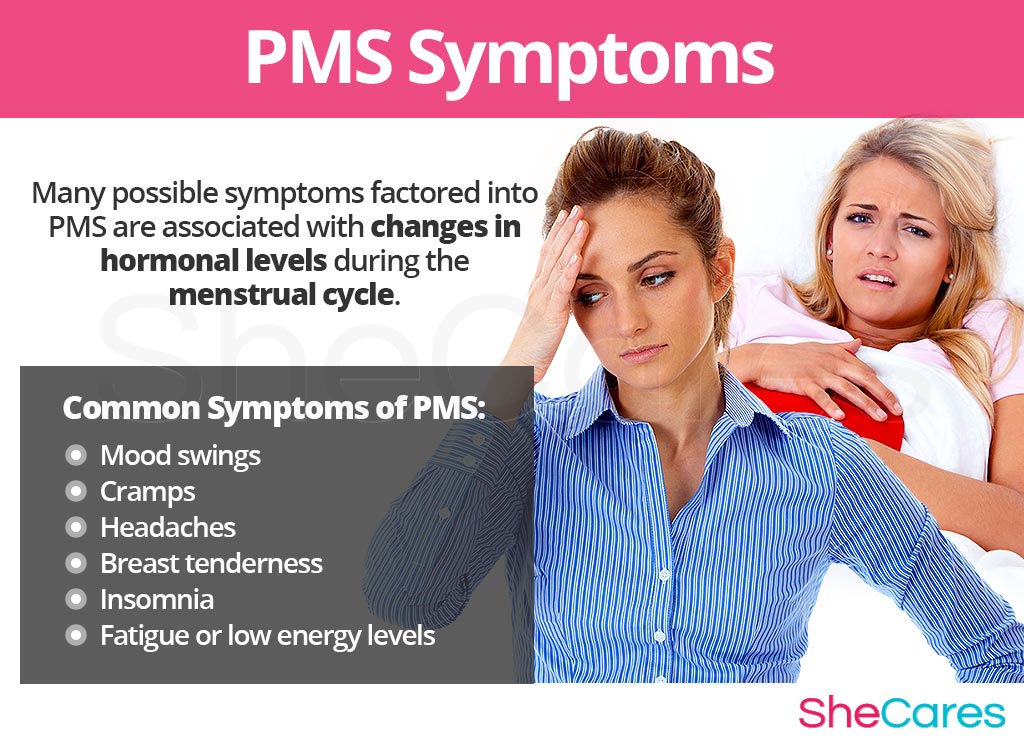
Treatments
PMS symptoms can vary greatly from woman to woman, so there is no “one size fits all” treatment. The symptoms of PMS are connected to hormonal imbalance, so treatments may address this root cause, or they may focus on managing the individual symptoms.
Three Approaches to Treat PMS
Three levels of approaches can be considered for treating PMS symptoms. These are categorized as: (1) Lifestyle Changes, (2) Alternative Medicine, and (3) Pharmaceutical Options.
In accordance with the severity of their symptoms, most women first try the least-risky treatment type for PMS symptoms: lifestyle adjustments. Then, if these changes are ineffective, a different approach may be attempted. Pharmaceutical options are generally seen as a last resort for only the most persistent and severe symptoms.
Lifestyle Changes for PMS
Lifestyle changes are a comprehensive way to lead to overall wellness, which in turn reduces the severity of PMS symptoms, and in some cases, can eliminate them altogether. Implementing changes in habit entails little to no health risk, although it does require a modicum of dedication. Healthy eating, stress reduction, and quitting smoking are some of the best ways to reduce PMS symptoms.
These changes can go a long way to improve overall health, but in general, they do not address the hormonal imbalance that is at the root of PMS symptoms. For that reason, further treatment may be necessary for more severe symptoms. Alternative medicines are a safe and natural option to help with this.
Alternative Medicine for PMS
There are many different types of alternative medicine, but supplements in particular can be the most helpful in terms of reducing PMS symptoms. There are two types of supplements that can address the underlying hormonal imbalance behind PMS symptoms: phytoestrogenic and hormone-regulating herbal supplements.
Phytoestrogenic herbal supplements
These supplements - such as soy, black cohosh, and red clover - contain estrogen-like compounds from plants. These compounds behave like a weaker form of estrogen in the body. This can help treat symptoms that stem from low estrogen levels during the menstrual cycle, but not necessarily for symptoms caused by other hormonal changes.Hormone-regulating herbal supplements
These supplements, such as Macafem, do not contain any natural or artificial hormones. Instead, they are rich in essential nutrients and unique alkaloids that stimulate the hormonal glands, helping them produce the hormones the body needs at balanced levels. This helps not only with estrogen levels, but also progesterone and other hormones. Because they support the body rather than add external hormones, they are considered a natural way to treat PMS symptoms.Additionally, there are other types of supplements that can also relieve PMS symptoms, or at least make them more manageable, including vitamins and other herbal supplements.
In many cases, a combination of healthy lifestyle adjustments and alternative supplements is the most effective way to relieve PMS symptoms and address the underlying hormonal imbalance. However, for incredibly severe symptoms that completely impede daily functioning and do not respond to other treatment, medical intervention may be necessary.
Pharmaceutical Options for PMS
These options typically entail more risk than the above approach, and they generally require a prescription from an MD. These treatment methods may not be appropriate for all women, depending on their medical history. There are two types of PMS medications women may consider: hormonal interventions and mood-regulating medication.
The approaches above can be combined as necessary to form a personalized treatment that best addresses the PMS symptoms an individual woman is experiencing. Many women find that all of their PMS symptoms are relieved with a mix of healthy habits and alternative supplements.
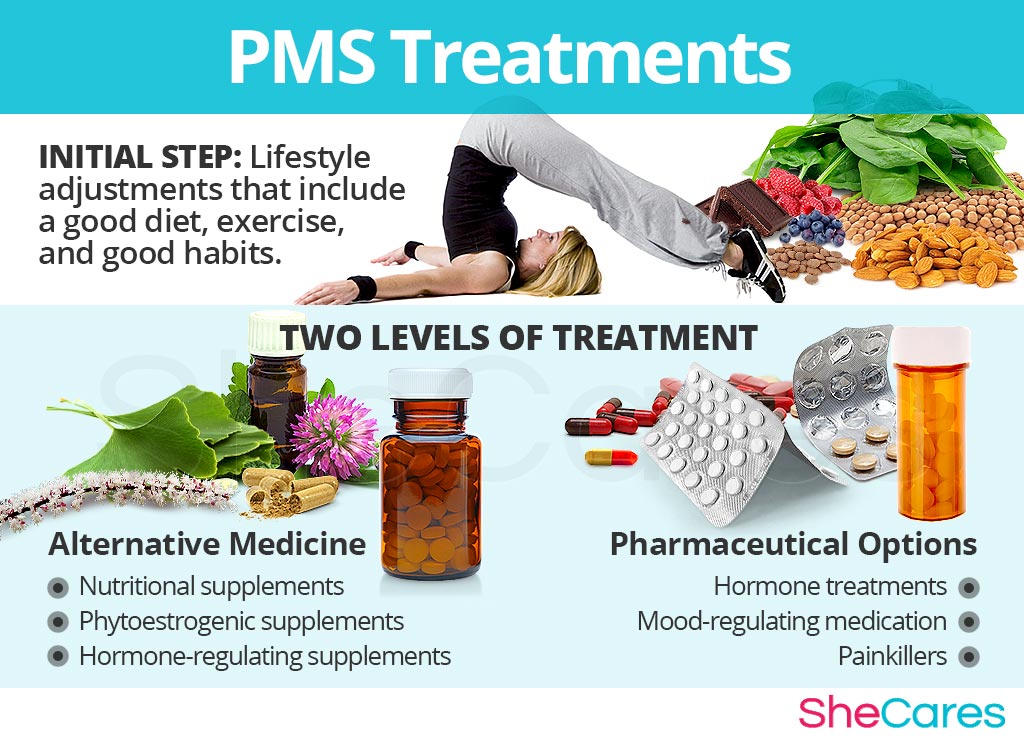
Sources
- Appiani, F.J. & Carroll, B.T. (2014). Levonorgestrel intrauterine device (IUD) exacerbation of PMS symptoms. Annals of Clinical Psychiatry, 26(2), 146-147.
- Loch, E.G. , Selle, H. & Boblitz, N. (2000). Treatment of premenstrual syndrome with a phytopharmaceutical formulation containing Vitex agnus castus. Journal of Women's Heath & Gender-based Medicine, 9(3), 315-320. Retrieved from https://www.ncbi.nlm.nih.gov/pubmed/10787228
- Matsumoto, T. , Asakura, H. & Hayashi, T. (2013). Does lavender aromatherapy alleviate premenstrual emotional symptoms?: a randomized crossover trial. BioPsychoSocial Medicine, 7, 12. doi: 10.1186/1751-0759-7-12
- Office on Women's Health. (2014). Menstruation and the menstrual cycle fact sheet. Retrieved February 26, 2017, from https://www.womenshealth.gov/publications/our-publications/fact-sheet/menstruation.html
- Office on Women's Health. (2014). Premenstrual syndrome (PMS) fact sheet. Retrieved February 26, 2017, from https://www.womenshealth.gov/publications/our-publications/fact-sheet/premenstrual-syndrome.html
- Tsai, S.Y. (2016). Effect of Yoga Exercise on Premenstrual Symptoms among Female Employees in Taiwan. International Journal of Environmental Research and Public Health, 13(7), 721. doi: 10.3390/ijerph13070721
- Yonkers, K.A. , Shaughn O'Brien, P.M. & Eriksson, E. (2008). Premenstrual syndrome. Lancet, 371(9619), 1200-1210. doi: 10.1016/S0140-6736(08)60527-9
